Dog Walking Through Class Divisions in New York City
Posted on October 18, 2019“Companion species are relentlessly becoming-with.”
-Donna Haraway
What if the hidden forces underlying growing class divides among New York City humans could be surfaced through a dog’s sense of smell?
Earlier this year, I worked as a dog walker in lower Manhattan, following a daily loop from historic Wall Street to the relatively modern Battery Park City to the wealthy homes of Tribeca. As I made my way through these landscapes with my dog companions, we encountered many vignettes of class division. For example, I once found myself picking up the poop of an elderly dachshund next to the New York Stock Exchange the day of Slack’s IPO. I had made $9 in the process, while one door down, Slack’s CEO had made $1.7 billion.
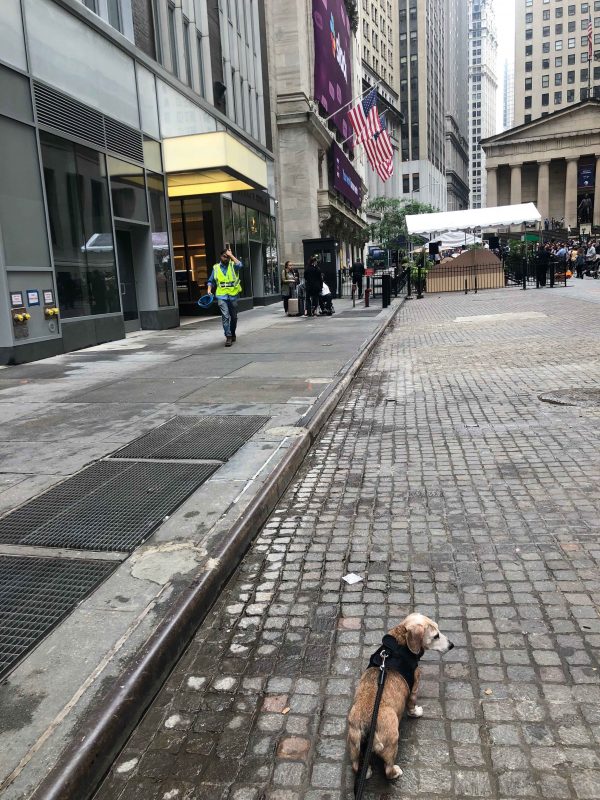
Duncan the dog lived next to the New York Stock Exchange. This was taken the day of Slack’s IPO – June 18, 2019 Photo: M. Young
As gig economy workers, Manhattan dog walkers make low wages while tending to the pets of some of the country’s wealthiest households [1]. They are part of a larger ecosystem of domestic workers, food delivery workers, doormen and others that I saw providing care and convenience to local residents [2]. I would often interact with nannies and house cleaners – all women of color – taking care of children and keeping households running. Something always made me feel uneasy about seeing this ecosystem in action, though I have several friends who too depend on such domestic workers. It’s not that families shouldn’t have help, but there’s a troubling asymmetry of who is cared for and who isn’t in American society.
Dogs themselves are symbols of wealth and status. Once people on the street would realize that I was not the dog’s owner, but just the walker, I was surprised at how often I would get asked how much the dog cost. In one of the fancier buildings on my route, a Wag dog walker actually stole a dog [3]. They were quickly caught, thanks to the many surveillance tapes in the building. Many homes I visited also had nanny or pup cams. Some were even motion sensitive, swiveling and turning to follow my every step.
I walked neighborhood blocks in great detail, becoming familiar with each tree or scaffolding that my dog partners paused to investigate. The dogs were full of enthusiasm and curiosity, sniffing to see who had passed by a given lamppost, finding what squirrel might be hiding in a bush or sensing when their owner was about to cross our path. Dogs have the incredible ability to smell past, present and future, detecting residues of narratives from neighborhood infrastructure or the oncoming breeze. 
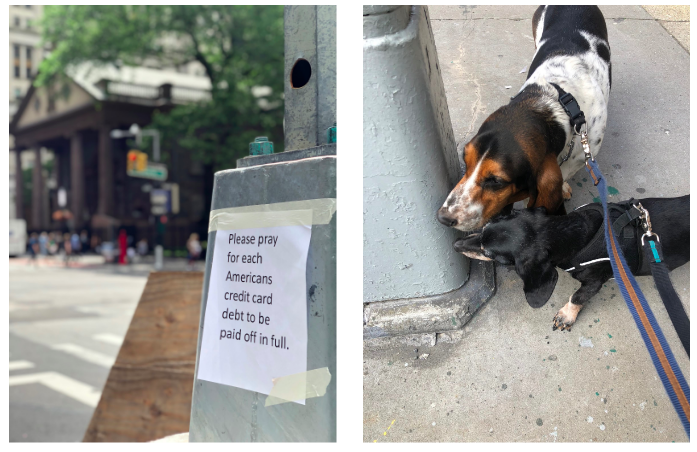
Left: A sign I saw someone had posted the same day of Slack’s IPO. Right: Bean and Murphy perhaps picking up such narratives of class divisions. Photos: M. Young
But what story do these narratives tell? Being a dog walker left me with many questions about the stratification of a city I thought I knew. I couldn’t quite make sense of it, but maybe with my dog collaborators’ wisdom, we might be able to understand more together. In Donna Haraway’s book “Staying With The Trouble,” she puts forth the notion of sympoiesis or “making-with” – a type of cross-species collaboration to heal the ills of our individualistic society [4]. Alone, each species cannot see the full landscape they are trying to navigate, but together we might actually create a new world.
On String Figures and Dog Leashes 
“String figures can be played by many, on all sorts of limbs, as long as the rhythm of accepting and giving is sustained. Scholarship and politics are like that too – passing on in twists and skeins that require passion and action, holding still and moving, anchoring and launching.”
-Donna Haraway
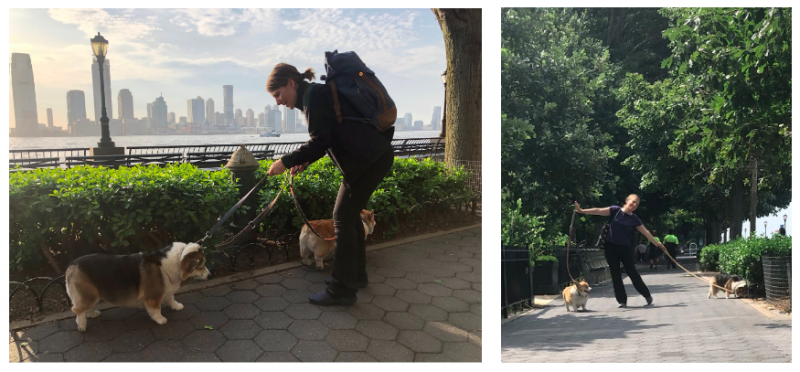
Me getting tangled up in string figuring with Ray and Cherry. Photos: B. Cleary (left), S. Hsieh (right)
After their original walker got injured, I was asked if I wanted to walk Ray and Cherry, two sassy corgis in Battery Park City. Although Ray was known to be a bit mischievous, often flopping down mid walk, I jumped at the chance to become-with these two dogs full of personality.
“You know, with Ray, you just have to show him who’s the boss.”
My manager made it seem simple, but her words would grow to haunt me. I’d show up at the apartment to find Ray sprawled on the floor in his typical corgi blob position. I’d slide my foot under his rear to hoist him up like a car jack until eventually he would grumpily arise from his slumber. Any sense of victory that may have given me quickly vanished once we actually started the walk. There was no question about who was in charge.
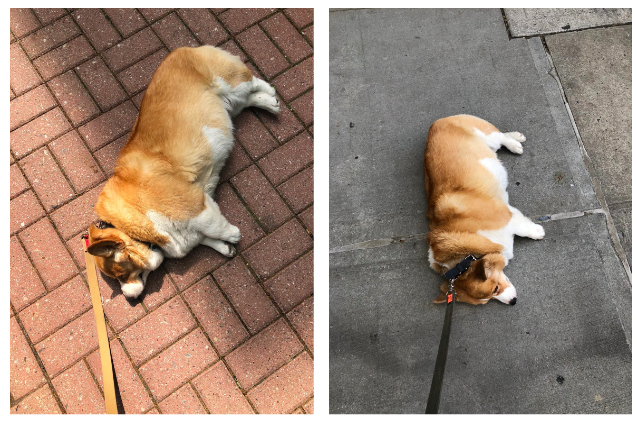
Examples of me “walking” Ray. Photos: M. Young
Being the showman that he was, Ray’s other favorite move was “the belly dance.” He would go belly up and shimmy right and left on his back until a full crowd of people would gather to take photos and supply ample tummy rubs.
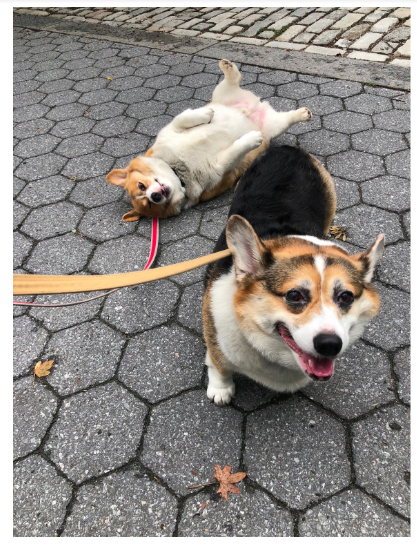
Ray mocks my dog walking abilities. Photo: M. Young
“I think he’s winning,” I told my friends.
Though Ray sometimes left me flustered, mostly I found myself laughing to the point of tears by his antics. It was hard to believe how big spirited this little corgi was. I had to acknowledge how much of a pull he was having on my being – that our walks were evidence of a complex relationship beginning to blossom. Over time, he didn’t flop as much, though continued to perform for his fans with two or three belly dances per walk.
Anyone who has ever walked a dog knows the interesting feedback loop it produces. After thousands of years of man and dog “becoming-with,” a dog’s outward behavior often mirrors their human’s inner state [5]. The ideal walks were where I was simply “walking-with,” fully present to the surroundings and not thinking too hard about trying to control things.
The leash is not meant as a pulling or dragging mechanism, but a vehicle for cross-species “making-with” and string figuring. Haraway refers to creating string figures like Cats Cradle as a method and metaphor for “making-with.” Playing such games with string might be a way to collaborate across species and an example of how we can create together. As she says, “string figures are like stories; they propose and enact patterns for participants to inhabit, somehow, on a vulnerable and wounded earth.” [4] For example, when Cherry the corgi would suddenly pull back, I would gently pull her forward until she started moving again. In the process, the leash would tighten or sway. She might step over it with her paw and get a big tangled. She might cross under Ray’s leash and create a pattern of string in that way.
What I eventually learned though is that she only pulled back when I pulled forward. If I let the leash go slack when she paused, she would move forward again on her own. As Haraway states, “Alignment in tentacular worlding must be a seriously tangled affair!” Walking two corgis at once demonstrated exactly this kind of dance. The corgis would careen back and forth, speed up and slow down and, often, we would end up in a bit of a tangle together. In the process, I learned to notice the things my dog companions were interested in – tree trunks, lampposts, mailboxes, garbage cans, or the wind off the Hudson. I learned to pick up on their cues and they learned to read me as well.
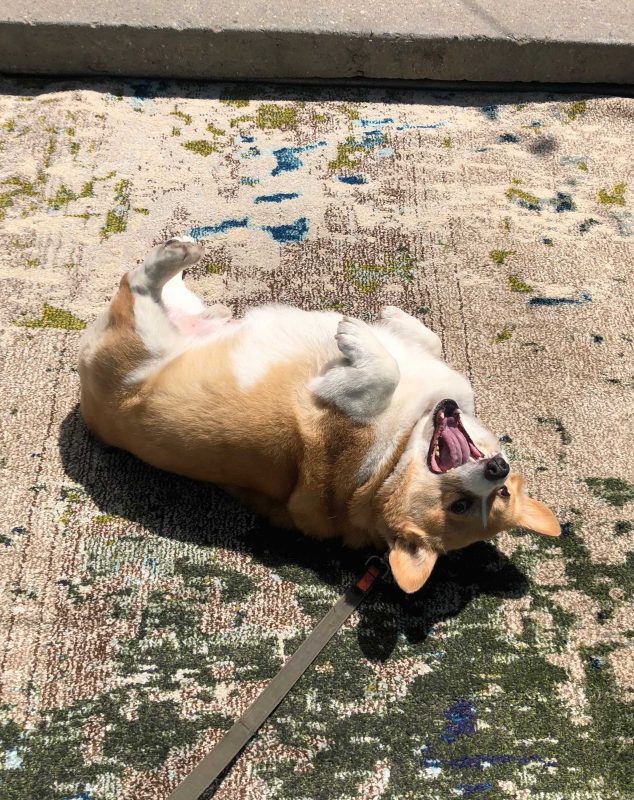
Ray working the crowds of Battery Park City. Photo: M. Young
Before I went back to school, I had to give up my dog walking route. The corgis’ new walker seemed shockingly high energy and bubbly compared to my low key ways. I prepped her with all kinds of tips about how to get Ray back up when he flops or how to cajole Cherry forward. However, as soon as I handed the leashes over, I watched in amazement as the corgis trotted along right at her heels. I had never seen them walk that fast.
So were the starts and stops and belly dances somehow my doing? All this time, I thought I was reacting to their behavior, but maybe they were just reacting to me – some subconscious energy state I didn’t realize I was giving off. What else could they detect about the hidden dynamics at play in the humans around them? What histories could they smell? What futures could they sense? What were we mirroring in each other? Together, what new worlds might we create?
-Miriam Young
References
- “It’s A Short Leash For Dog Walkers Trying To Make It In The Gig Economy”. 2018. KQED. Accessed October 9 2019. https://www.kqed.org/news/11709039/short-leash-for-independent-dog-walkers-trying-to-make-it-in-the-gig-economy.
- “About Us | National Domestic Workers Alliance”. 2019. Domesticworkers.Org. Accessed October 18 2019. https://www.domesticworkers.org/about-us.
- “Dog Allegedly Stolen From His Home By Wag Walker With Access To Family’s Lockbox Code”. 2019. Cbsnews.Com. Accessed October 9 2019. https://www.cbsnews.com/news/wag-app-dog-returned-after-he-was-allegedly-stolen-by-dog-walker-battery-park-nyc-2019-06-18/.
- Haraway, Donna Jeanne. Staying with the Trouble: Making Kin in the Chthulucene. Durham, NC: Duke University Press, 2016.
- D’Aniello, B., Semin, G.R., Alterisio, A. et al. Anim Cogn (2018) 21: 67. https://doi.org/10.1007/s10071-017-1139-x